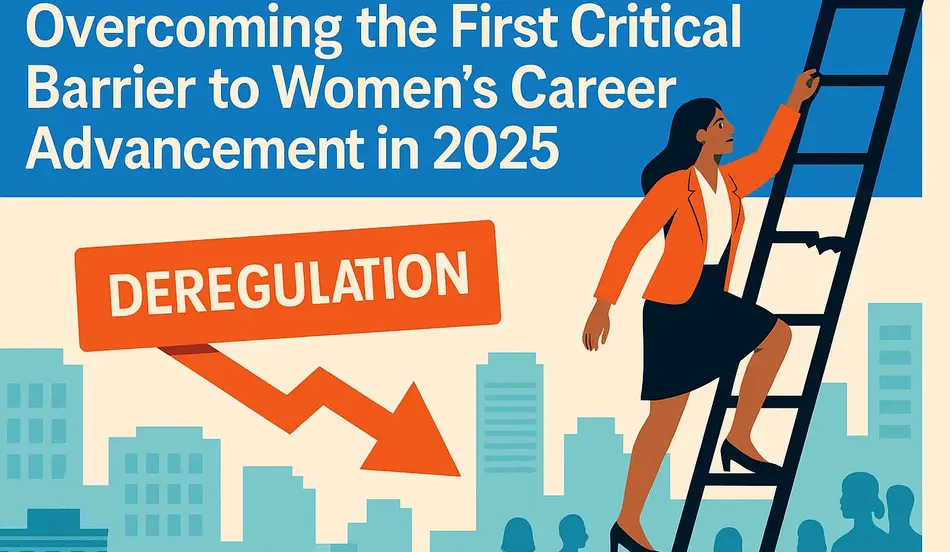Understanding the Broken Rung Phenomenon in Career Advancement
In today’s competitive workplace, women face a unique challenge that’s often overlooked in career development conversations: the broken rung. While much attention focuses on the glass ceiling at executive levels, research shows that the first step up to management—the broken rung—is where women face the greatest barriers to career advancement. According to workplace experts, women are often promoted based on proven performance while their male counterparts advance based on perceived potential.
“Women are often promoted on performance versus our male colleagues are promoted on potential,” explains Cate Luzio, founder and CEO of Luminary, a global networking platform for women and allies. “That’s statistically proven.”
This fundamental disparity creates a career advancement bottleneck that impacts women’s professional trajectories for years to come. Understanding how to navigate this broken rung is essential for women seeking to build thriving careers in any industry.
Key Strategies for Overcoming the Broken Rung in Your Career Path
Self-Advocacy: The Missing Skill in Women’s Career Advancement
One of the most critical skills for overcoming the broken rung in career advancement is self-advocacy. As Luzio explains, “Self-advocacy is one that I think we all need. When you look at what women want to accomplish, one of the biggest skills that’s lacking is talking about ourselves and why we deserve something—not why we need it, why we deserve it.”
Building a strong business case for your career advancement requires documenting achievements, quantifying results, and clearly articulating your value proposition. Women must learn to speak confidently about their accomplishments without downplaying their contributions.
Research from McKinsey & LeanIn.org shows that women who actively self-advocate are more likely to overcome the broken rung and achieve management positions. However, many women hesitate to promote their accomplishments due to concerns about being perceived as boastful or aggressive.
Setting Boundaries Around Stretch Opportunities
Taking on stretch assignments can demonstrate readiness for career advancement, but there’s a fine line between proving yourself and being taken advantage of. The broken rung phenomenon often manifests when women take on higher-level responsibilities without corresponding recognition or compensation.
When accepting stretch opportunities, establish clear parameters: “This is amazing, I’m really excited about it, but how long will I do this in my current role before there is an expanded role or an expanded opportunity?” Setting these boundaries ensures that your additional efforts translate to actual career advancement rather than just additional work.
Luzio advises creating a roadmap with your manager: “Set out a roadmap and making sure if you’re hitting these incredible milestones and you’re doing the work, what does that mean for you?” This approach transforms stretch assignments from potential exploitation into strategic stepping stones over the broken rung.
Conducting a Career SWOT Analysis
To effectively navigate the broken rung in your career advancement journey, start with a comprehensive self-assessment. Luzio recommends conducting a career SWOT analysis:
- Strengths: Identify your core competencies and unique value proposition
- Weaknesses: Recognize areas for development (not as negatives, but as growth opportunities)
- Opportunities: Explore potential paths for advancement within your organization or industry
- Threats: Acknowledge challenges like limited experience or market conditions
“Do a career SWOT for yourself,” Luzio advises. “Identify for yourself what you perceive to be your strengths and your weaknesses. And with weaknesses, don’t look at that as a negative. Those are always areas for development.”
This structured approach helps women identify specific skills they need to develop to overcome the broken rung in their career advancement journey. It also provides a framework for conversations with managers about growth opportunities.
The Power of Mentorship in Breaking Through Career Advancement Barriers
Different Types of Mentorship for Career Growth
Mentorship plays a crucial role in helping women overcome the broken rung in career advancement. However, not all mentoring relationships look the same. Luzio identifies several types of mentorship that can be valuable:
- Long-term mentors: Established relationships that provide ongoing guidance and support
- Transactional mentors: Short-term connections focused on specific questions or challenges
- Peer mentors: Colleagues at similar career stages who provide mutual support
“My approach to mentoring is any relationship that I have, I think there’s a mentoring component of that,” Luzio explains. “I never sought out mentors in finance. They sought me out mainly because of my performance, my reputation, that visibility I talked about earlier.”
For women facing the broken rung challenge, developing a diverse mentorship network can provide multiple perspectives and opportunities for career advancement. According to a study by Catalyst, women with mentors are more likely to receive promotions and experience greater career satisfaction.
Finding Mentors Within Your Organization
If you’re struggling to identify potential mentors to help with your career advancement, Luzio suggests a direct approach: “Talk to your manager and say, ‘You can’t be my mentor because you’re my direct manager. Is there anyone in your network that you could have act as my mentor?'”
Many organizations offer formal mentoring programs specifically designed to address the broken rung issue. These structured programs can connect women with senior leaders who might otherwise be inaccessible. However, Luzio notes that “the chemistry and that organic nature does help mentorship so much.”
When seeking mentors, look for individuals who have successfully navigated the broken rung in their own career advancement journey. Their insights about organizational dynamics and unwritten rules can be invaluable.
Leadership Development: Starting Before You Become a Manager
Building Influence at Any Career Stage
A critical insight for overcoming the broken rung in career advancement is that leadership development begins long before you receive a management title. As Luzio emphasizes, “You can be in a leadership role or take a leadership approach in any role. It does not matter if you are an individual contributor, a people manager, whether you’re the senior most person in the room or the most junior.”
Building influence—the ability to impact decisions and inspire others—is a skill that can be developed at any career stage. Women who demonstrate leadership behaviors before being promoted are more likely to overcome the broken rung because they’re already perceived as leaders.
Practical ways to build influence include:
- Volunteering for cross-functional projects
- Contributing thoughtful insights during meetings
- Helping colleagues succeed
- Proposing solutions rather than just identifying problems
- Developing expertise that others rely on
By demonstrating leadership capabilities before seeking promotion, women create a compelling case for their career advancement that helps them overcome the broken rung.
Transitioning Successfully to Management
For women who have successfully navigated the broken rung and moved into management, the next challenge is excelling in the new role. Luzio notes that this transition adds “so much complexity into our lives. Lots of people get into people manager roles and go, ‘I hate this administration stuff. It takes so much time.'”
Successful management requires creating “an environment for collaboration, for positive and open thinking for idea generation,” Luzio explains. This collaborative approach leads to “innovation, that leads to inclusion, that leads to trust.”
Women who excel as managers after overcoming the broken rung in career advancement often become what Coursera’s “Super Bosses” course describes as leaders who “constantly pump out other great leaders.” They find talented people, mentor them, sponsor them, cultivate their skills, and then let them advance—creating a positive cycle that helps other women overcome the broken rung.
Global Perspectives on Women’s Career Advancement
While the broken rung phenomenon affects women globally, its manifestation varies across cultures. Having led global teams, Luzio has conducted women’s roundtables worldwide and found that “the topics, the themes that continue to hold us back are very similar. I think it’s nuanced by culture.”
Cultural context significantly impacts how women navigate career advancement challenges. “If you’re sitting in Saudi Arabia versus New York City, it’s very nuanced around how you approach your male peers and your male bosses,” Luzio observes. “It’s very nuanced around communication style. The same in India, the same in China.”
Despite these differences, progress is happening globally. “The cultural shift that I saw over the course of five or six years to the cultural shift now that’s happened. It’s dramatic,” Luzio notes about her experiences in the Middle East.
For organizations with global teams, addressing the broken rung in career advancement requires cultural sensitivity and localized approaches. What works in one region may not be effective in another, even though the fundamental challenges remain similar.
Hiring? Create Pathways Over the Broken Rung
Is your organization committed to helping women overcome the broken rung in career advancement? WhatJobs connects forward-thinking companies with diverse talent seeking equitable growth opportunities. Our platform helps you find candidates ready to thrive in your organization while building inclusive pathways to leadership.
Practical Action Steps to Overcome the Broken Rung
For women determined to overcome the broken rung in their career advancement journey, Luzio offers several practical action steps:
1. Be Visible and Engaged
“Show up as a leader every day,” Luzio advises. “Raise your hand, be visible and keep your head up. Women and women of color are told to keep our heads down. Never listen to that. Be visible and be engaged and show them why you deserve to be in that seat.”
Visibility is crucial for overcoming the broken rung because decision-makers need to see your contributions and leadership potential. Look for opportunities to showcase your work through presentations, volunteering for high-profile projects, and sharing accomplishments appropriately.
2. Set Short-Term Career Goals
Rather than creating vague long-term plans, Luzio recommends focusing on “one to two year increments. Like, where do I wanna be in one to two years? And by the way, if you have a compensation number that you wanna be making, put that down right. And what’s gonna help you get there.”
These shorter timeframes make career advancement more manageable and allow for course corrections as opportunities emerge. They also provide clear metrics for measuring progress in overcoming the broken rung.
3. Develop Both Technical and People Skills
Balanced skill development is essential for career advancement beyond the broken rung. “You must continue to develop those skills as what I would call an operator,” Luzio emphasizes for aspiring leaders.
Technical expertise establishes credibility, while people skills enable effective leadership. Women who develop both dimensions position themselves strongly for advancement opportunities.
4. Build Confidence in Your Abilities
Perhaps most importantly, Luzio urges women to “be confident in your abilities. Be confident in the skills that you’ve built and be confident in that you can continue to develop those skills and hone those skills and invest in skills that you don’t have.”
This confidence is fundamental to overcoming the broken rung in career advancement. “Forget imposter syndrome,” Luzio advises. “If you’re in the role, you’re in the role for a reason, then perform in that role and excel in that role. And always, always, always bet on yourself.”
By implementing these strategies, women can navigate the broken rung more effectively and create meaningful career advancement opportunities for themselves and others who follow.
FAQ: Navigating the Broken Rung in Career Advancement
What exactly is the “broken rung” in career advancement?
The broken rung refers to the first critical barrier in women’s career advancement—specifically, the initial step from entry-level positions to first-level management. Unlike the “glass ceiling” that blocks advancement to executive positions, the broken rung occurs much earlier in women’s careers. Research shows that women are significantly less likely than men to be promoted to manager, creating a gender gap that widens at each subsequent level. This phenomenon occurs largely because women are often promoted based on proven performance while men are more frequently promoted based on perceived potential, creating a fundamental disparity in career advancement opportunities.
How can women effectively self-advocate to overcome the broken rung in career advancement?
Effective self-advocacy to overcome the broken rung in career advancement requires several key approaches. First, document your achievements with specific metrics and outcomes to build a strong business case for promotion. Second, practice articulating your accomplishments confidently without downplaying your contributions—focus on why you deserve advancement, not why you need it. Third, regularly communicate your career aspirations to decision-makers and ask for specific feedback on what’s needed to reach the next level. Fourth, build a network of allies who can advocate for you in rooms where decisions are made. Finally, when taking on stretch assignments, clearly establish expectations about how successful completion will contribute to your career advancement. Remember that self-advocacy is a skill that improves with practice and is essential for navigating past the broken rung.
What role does mentorship play in helping women overcome the broken rung in their career paths?
Mentorship plays a crucial role in helping women overcome the broken rung in career advancement by providing guidance, insights, and advocacy. Effective mentors offer several key benefits: they provide insider knowledge about organizational dynamics and unwritten rules; they offer feedback on areas for development that might not be addressed in formal reviews; they can recommend high-visibility opportunities that showcase your capabilities; and perhaps most importantly, they can evolve into sponsors who actively advocate for your advancement when promotion decisions are being made. Women benefit from developing diverse mentorship networks including long-term mentors, transactional mentors for specific challenges, and peer mentors at similar career stages. Research consistently shows that women with strong mentorship relationships are more likely to successfully navigate the broken rung and achieve management positions.
How can organizations address the broken rung problem in women’s career advancement?
Organizations can address the broken rung problem in women’s career advancement through several evidence-based strategies. First, implement transparent promotion criteria that focus on objective performance metrics rather than subjective assessments that may favor perceived potential over proven results. Second, establish formal sponsorship programs that connect high-potential women with senior leaders who can advocate for their advancement. Third, create leadership development opportunities specifically designed to prepare women for management roles before promotion decisions are made. Fourth, set specific targets for gender representation at first-level management and hold leaders accountable for progress. Fifth, examine how stretch assignments are distributed and ensure women have equal access to career-enhancing opportunities. By systematically addressing these areas, organizations can help repair the broken rung and create more equitable career advancement pathways for women.
Overcoming the broken rung in career advancement requires both individual strategies and organizational change. By developing self-advocacy skills, building strong mentorship networks, demonstrating leadership before promotion, and implementing the practical steps outlined above, women can navigate this critical barrier more effectively. Organizations that recognize and address the broken rung phenomenon not only advance gender equity but also benefit from the full range of talent and perspectives that diverse leadership provides.
For more resources on career advancement and professional development, explore job opportunities at WhatJobs where you can find companies committed to equitable advancement practices.






